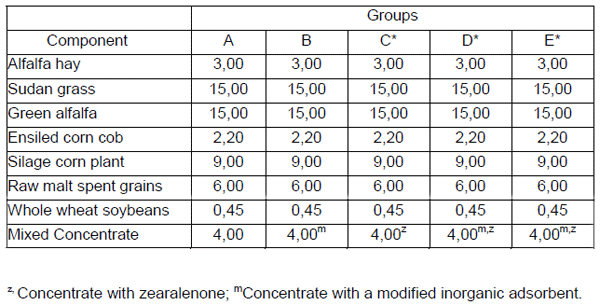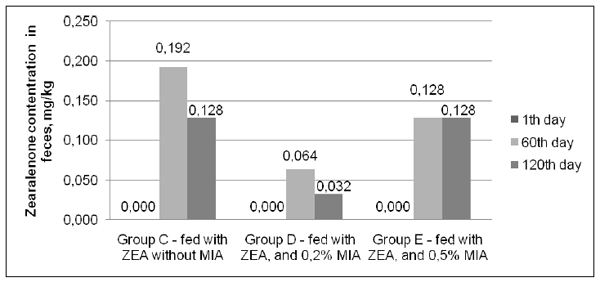Preliminary Results of Minazel-Plus® a) Effects on Levels of Zearalenone in Milk, Urine and Feces in Holstein Friesan Cows in Serbia
Published: January 27, 2014
By: Srdjan Nešic*, Marko Vasiljevic** and Jasna Bosnjak***
* M.Sc. Srdjan Nesic, Ruminant Specialist, New-Life Mills, Ontario, Canada
**Marko Vasiljevic, Dipl.Ing. and Technical Director of Patent co., private company from Serbia
***corresponding author: Jasna Bosnjak, DVM
**Marko Vasiljevic, Dipl.Ing. and Technical Director of Patent co., private company from Serbia
***corresponding author: Jasna Bosnjak, DVM
a) MINAZEL-PLUS® , is a trademark of a modified inorganic adsorbent property of Patent Commerce and in Mexico, of Lapisa, S. A. de C.V.
Summary
The aim of this study was to determine the influence of a modified inorganic adsorbent (MIA) upon the presence of residues of zearalenone (ZEA) in milk, urine and feces of Holstein-Friesian cows fed diets naturally contaminated, or not, with ZEA and supplemented with different levels of MIA.
For the experiment that lasted 120 days, a total of 60 Holstein-Friesian, cows were randomly allotted in groups of 12 each to 5 experimental treatments. Group A, received a feed without ZEA contamination and without MIA; Group B, received a diet without ZEA contamination but with 0,2% MIA; Group C, received a diet contaminated with 2,55 mg/kg of ZEA, without MIA; Group D was fed a diet contaminated with 2,40mg/kg of ZEA to which 0,2% MIA was added; and Group E received a diet contaminated with 2,33mg/kg of ZEA supplemented with 0,5% MIA. All analyses of ZEA in milk, urine and feces were carried out at weekly intervals on representative samples of each experimental group.
The highest level of ZEA in milk (0,256 mg/kg), urine (0,25 mg/l) and feces (0,129 mg/kg) was observed in Group C. Supplementation of 0,2% and 0,5% MIA in the feed significantly (P<0.05) reduced the ZEA concentration in milk and urine. However the similar concentration of ZEA in Group D on the 60th and the 120th day of the experiment (0,128mg/kg), and the decreasing values of ZEA in feces on the 60th day (0,064mg/kg) and 120th day (0,032mg/kg) in E Group implies that 0,2% of MIA supplementation effectively reduces ZEA concentration in feces and that it was as effective as 0,5% MIA supplementation.
This study indicates that it is essential to conduct further research in order to have clear insight into MIA induced minimization of ZEA transmission into milk and the feasibility of using urine and feces samples as bio-indicators of ZEA exposure and of ZEA presence in milk.
Introduction
Zearalenone (ZEA) is a non-steroidal estrogen mycotoxin biosynthesized through a polyketide pathway by numerous species of Fusarium, including F. graminearum, F. culmorum, F. equiseti, and F. crookwellense (Bennett and Klich, 2003). The effects of ZEA and its metabolites are assumed to be toxic due to their structural shape similar to that of naturally occurring estrogens (estradiol, estrone and estriol). Given this similarity they interact with estrogen receptors in competition with 17β-estradiol (Kuiper et al., 1998).
Feeding ruminants forages or concentrate mixtures containing mycotoxins is less harmful compared to feeding it to non-ruminants (Whitlow, 1999). In ruminants, ZEA is converted by the rumen flora into its hydroxy-metabolite, α−zearalenol (approximately 90%) and to a lesser extent β- zearalenol (Kennedy et al., 1998). Previous studies (Diekman and Green,1992; Dänicke et al., 2005; Seeling et al., 2005) consider that low zearalenone susceptibility of dairy cattle occurs due to lower rate of absorption and its conversion in the liver to the less potent α-zearalenol. Nevertheless, ZEA is present in milk after dairy cows are fed ZEA containing diets (Zinedine et al., 2007). Its derivatives can also be detected in milk (Coffey et al., 2009). Additionally, in farm animals, the concentration of ZEA and its metabolites in urine can be used as biomarkers of ZEA exposure (Kleinova et al., 2002).
The use of mycotoxin adsorbents as feed additives is one of the most promising and widely used approaches to reduce the risk for mycotoxicosis in farm animals, and to minimize the carry-over of mycotoxins from contaminated feeds into animal-derived products (Ramos et al. 1996; Huwig et al. 2001). According to Sabater-Vilar et al., 2007, the efficacy of inorganic compounds to adsorb ZEA has been investigated but results have been un-consistent. However, addition of organic cations to change the mineral surface of an inorganic compound has been more effective in adsorbing mycotoxins (Bocarov-Stancic et al. 2011., Nešic et al. 2011., Trailovic et al. ,2013.). Additionally, in vivo studies of Nešic et al., 2008; have shown that organic modification of the surface of an inorganic adsorbent is effective in alleviating signs of ZEA intoxication in female pigs, known as the estrogenic syndrome.
The aim of this study was to determine the effects of MIA upon the presence of ZEA residues in milk and to validate the reliability of ZEA concentration in urine and feces as a possible biomarker of ZEA exposure in Holstein dairy cows fed ZEA contaminated diets.
Materials and Methods.
The experiment was performed on a total of 60 Holstein-Friesian cows, similar in terms of origin, lactation number, and milk production. Cows were randomly allotted to five groups of 12 cows each. All cows were fed with forages free of ZEA (Table 1) and a concentrate (Table 2) naturally contaminated, or not, with ZEA. The experimental groups were: Group (A) was fed the uncontaminated concentrate without added MIA; Group (B) was fed a ZEA un-contaminated feed with 0,2% of MIA added in the concentrate; Group (C) was fed a concentrate with 2,55 mg/kg ZEA without MIA; Group (D) was fed a concentrate mixture with ZEA (2,40mg/k) and 0,2% MIA; Group (E) was fed a mixture with ZEA 2,33mg/kg plus 0,5% MIA . The experiment lasted 120 days.
All cows were fed with identical meals according to their nutritional needs (NRC, 2001), while optimization was carried out with the software program OPTIMIX (Adamovic et al., 1993).
Table 1. Composition of daily intake (kg/cow).

Table 2. Composition of the concentrates,%

The maize grain used as a component of the concentrate mixture in groups C, D and E was naturally contaminated in the field with ZEA. Analysis of ZEA concentration in mixed concentrates was done throughout the experiment by thin layer chromatography (TLC) on the 1st, 60th and 120th day.
Analyses of ZEA in milk, urine and feces were carried out on a representative sample of each group. Representative samples were formed of collective milk samples of each cow within every group. Concentration of ZEA in representative sample of milk was monitored once a week by TLC. Fluorometric analysis of samples of urine and feces were done on the 1st, 60th and 120th day of the experiment.
All results were statistically analyzed with ANOVA process with STATISTICA v.6 software (StatSoft, 2003).
Results and discussion.
Milk from cows that received the contaminated concentrate mixture, as part of their daily diet had presence of ZEA in milk as early as the second week of the experiment (Table 3). Our results are consistent with the findings of Hagler et al., 1980., that reported presence of ZEA 96 hours after cows started eating ZEA contaminated feeds. In our study ZEA was not detected in any of the experimental groups from week 3 to week 7. This could be because the concentration in milk of ZEA during those periods was so small that it was not detected using the TLC method.
The average difference in ZEA concentration in milk over the 120 day study between treatments E and C was significant (P<0.001). The highest value of ZEA in milk was found in group C, with the maximum concentration (0.256 mg/kg) being in the 10th week. The toxin was present in milk from cows in group C in weeks XII and XIII, which was not the case for any of the other groups. Although supplementation of MIA at the level of 0,5 % in the concentrate reduced ZEA to a great extent, usage of 0,2% MIA is as efficient to prevent ZEA secretion in milk.
Table 3. Zearalenone concentration in milk (mg/kg).

The presence of ZEA in urine was only detected in groups C and D. In group C was detected in the 60th and 120th day, whereas in group D was only detected in day 60th of the trial. (Figure1).
Figure 1. Concentration of zearalenone (mg/l) in urine samples of C and D groups.

Previous studies by Hasunuma et al., (2011) have indicated that the concentration of ZEA in urine from ruminants represent a good indicator of exposure to ZEA in cattle. Bearing this in mind, lower ZEA concentration in urine samples of group D (0,043 mg/l) in comparison to group C (0,085 mg/l) in day 120 can be attributed to the addition of 0.2% of MIA.
Studies done with the commercial implant of ZEA (Agag, 2004) reported that in rats, sheep, cattle, monkeys, dogs, rabbits and men, the major route of excretion of ZEA is in the feces. In our study (Figure 2), the highest concentration of ZEA in feces was in group C on day 60 (0,192 mg / kg) and on day 120 (0,128 mg/kg). Group D, had the minimum concentration of ZEA in feces throughout the experiment. Group E, at day 60 and at day 120 had a constant concentration of ZEA in feces. From the findings in this results it seems that the addition of MIA at a level 0,2% is optimal when cows are fed with ZEA contaminated feed.
Figure 2. Concentration of zearalenone (ZEA; mg/kg) in fecal samples for groups C, D and E.

Conclusions.
Supplementation of MIA at levels of 0,2 and 0,5% in concentrate mixtures contaminated with ZEA, effectively decreased concentration of ZEA in milk and urine in Holstein-Friesian cows. Usage of 0,2% MIA as a feed supplement had a higher impact than the inclusion 0,5% in reduction of ZEA in feces. To our knowledge, feces have not been previously used as a bioindicator of ZEA exposure in cattle. Therefore, further research will be conducted using high-performance liquid chromatography (HPLC) for determination of ZEA in feces as a possible bio-indicator of ZEA transmission into the milk.
References.
Adamovic, M., Lj. Sretenovic, M. Miloševic, Lj. Stoicevic, Z. Pavlovic. 1993. Program optimizacije obroka visokomlecnih krava. Proceedings of VII winter seminar on Agriculture, Donji Milanovac: 71-75. [ in Serbian]
Agag, B. I. 2004. Mycotoxin in food and feed 3-zearalenone. Ass. Univ. Bull. Environ. Res. 7(2): 156-179.
Bennett, J. W. and M. Klich. 2003. Mycotoxins. Clin. Microbiol. Rev. 16:497–516.
Bocarov-Stancic A., M. Adamovic, N. Salma, M. Bodroža-Solarov, J. Vuckovic and V. Pantic. 2011. In vitro efficacy of mycotoxins’ adsorption by natural mineral adsorbent. Biotech. Anim. Husbandry 27 (3): 1241-1251.
Coffey, R., E. Cummins and S. Ward. 2009. Exposure assessment of mycotoxins in dairy milk. Food Control. 20: 239–249.
Dänicke, S., K. Matthaus, P. Lebzien, H. Valenta, K. Stemme, K. H. Ueberschar, E. Razzazi-Fazeli, J. Bohm, G. Flachowsky. 2005. Effects of Fusarium toxin-contaminated wheat grain on nutrient turnover, microbial protein synthesis and metabolism of deoxynivalenol and zearalenone in the rumen of dairy cows. J. Anim. Physiol. Anim. Nutr. 89:303-315.
Diekman, M. A. and M. L. Green. 1992. Mycotoxins and reproduction in domestic livestock. J. Anim. Sci. 70:1615-1627.
Hasunuma, H., M. Takagi, O. Kawamura, C. Taniguchi, M. Nakamura, T. Chuma, S. Uno, E. Kokushi, D. Matsumoto, C. Tshering, E. Deguchi and J. Fink-Gremmels. 2012. Natural contamination of dietary rice straw with zearalenone and urinary zearalenone concentrations in a cattle herd. J. Anim. Sci. 90:1610–1616.
Hagler, W. M., G. Danko, L. Horvath,M. Palyusik an C. J. Mirocha, 1980. Transmission of zearalenone and its metabolite into ruminant milk. Acta Vet. Acad. Sci. H. 28 (2): 209-216.
Huwig, A., S. Freimund, O. Kappeli, H. Dutler. 2001. Mycotoxin detoxification of animals feed by different adsorbents. Toxicol. Lett.122:179–188.
Kennedy, D. G., S. A. Hewitt, J. D. McEvoy, J. W. Currie, A. Cannavan, W. J. Blanchflower and C. T. Elliot. 1998. Zeranol is formed from Fusarium spp. toxins in cattle in vivo. Food Addit. Contam. 15:393-400.
Kleinova, M., P. Zollner, H. Kahlbacher, W. Hochsteiner and W. Lindner. 2002. Metabolic profiles of the mycotoxin zearalenone and of the growth promoter zeranol in urine, liver, and muscle of heifers. J. Agric. Food Chem. 50:4769–4776.
Kuiper, G. J., J. G. Lemmen, B. Carlsson, J. C. Corton, S. H. Safe, P.T. Van der Saag, B. van der Burg and J. A. Gustafsson . 1998. Interaction of estrogenic chemicals and phytoestrogens with estrogen receptor b. Endocrinology. 139(10): 4252–4263.
Nešic, K., R. Resanonic, V. Nešic and Z. Sinovec. 2008. Efficacy of mineral and organic adsorbent in alleviating harmful effects of zearalenone on pigs performance and health. Act. Vet. 58: 211-219.
Nešic, K., R. Resanovic, D. Jakic-Dimic, V. Nešic. 2011. Efficiency of various feed additives on performance of broilers treated with T-2 toxin. Biotech. Anim. Husbandry. 27 (3): 705-711.
NRC. (National Research Council) 2001. Nutrient Requirements of Dairy Cattle, 7th ed., National Academy Press, Washington, DC.
Ramos, A. J., J. Fink-Gremmels and E. Hernandez. 1996. Prevention of toxic effects of mycotoxins by means of non-nutritive adsorbent compounds. J. Food Prot. 59: 631–641.
Sabater-Vilar, M., H. Malekinejad, M.H.J. Selman, M.A.M. van der Doelen and J. Fink-Gremmels. 2007. In vitro assessment of adsorbents aiming to prevent deoxynivalenol and zearalenone mycotoxicoses. Mycopathologia. 163:81–90.
Seeling, K, S. Dänicke, K. H. Ueberschar, P. Lebzien, G. Flachowsky. 2005. On the effects of Fusarium toxin-contaminated wheat and the feed intake level on the metabolism andcarryover of zearalenone in dairy cows. Food Addit. Contam. 22:847-855.
StatSoft, Inc. (2003): STATISTICA (data analysis software system), version 6.
Trailovic, J.N., S. Stefanovic and S.M.Trailovic. 2013. In vitro and in vivo protective effects of three mzcotoxin adsorbent against ochratixin A in broilers chicken. Br Poult Sci. (in press)
Whitlow, L. W, Jr. W. M. Hagler and B. A. Hopkins. 1999. Mycotoxin occurrence in farmer submitted samples of North Carolina feedstuffs: 1989-1997. J. Dairy. Sci. Vol 81(4):1186-1193 (Abstr.)
Zinedine, A., J. M. Soriano, J. C. Molto and J. Manes. 2007. Review on the toxicity, occurrence, metabolism, detoxification, regulations and intake of zearalenone: An oestrogenic mycotoxin. Food Chem. Toxicol. 45: 1–18.
This paper was presented at the XVI AMENA Congress in Puerto Vallarta, Mexico, October 2013.
Authors:
Join to be able to comment.
Once you join Engormix, you will be able to participate in all content and forums.
* Required information
Would you like to discuss another topic? Create a new post to engage with experts in the community.
Create a post20 de marzo de 2014
Thanks for a good article!
What methods were used for ZEA extraction and quantification?
Were any ZEA metabolites found in the samples?
Best regards, Gorbenko Z.G. ?? ????
Tolsa
17 de marzo de 2014
Thank you for this interesting article.
Do you have any data about the zea content in urine from the E group?
How do you explain the increased concentration of zea in feces when it is reduced at the lower dosage of MIA ?
What is the role of the mineral absorbent if no increased Zea is foud in feces?
Thanks for your comments.
Sincerely
Fernando Escribano Sáez Manager Animal Nutrition Marketing and development ofTolsa Group







